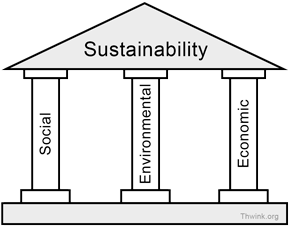Ability to Continue a Defined Behavior Indefinitely
Environmental Sustainability
![]() To define environmental sustainability we must first define sustainability. Sustainability is the ability to continue a defined behavior indefinitely. To define what environmental sustainability is we turn to the experts.
To define environmental sustainability we must first define sustainability. Sustainability is the ability to continue a defined behavior indefinitely. To define what environmental sustainability is we turn to the experts.
Herman Daly, one of the early pioneers of ecological sustainability, looked at the problem from a maintenance of natural capital viewpoint. In 1990 he proposed that: 1
1. For renewable resources, the rate of harvest should not exceed the rate of regeneration (sustainable yield);
2. [For pollution] The rates of waste generation from projects should not exceed the assimilative capacity of the environment (sustainable waste disposal); and
3. For nonrenewable resources the depletion of the nonrenewable resources should require comparable development of renewable substitutes for that resource.
This list has been widely accepted. It's an elegant abstraction, one that made me pause and read it three times when I first encountered it.
The list can be shortened into a tight definition. Environmental sustainability is the rates of renewable resource harvest, pollution creation, and non-renewable resource depletion that can be continued indefinitely. If they cannot be continued indefinitely then they are not sustainable.
Why this particular definition is important
This is discussed on the glossary page for sustainability.
Basically the world's standard definition of environmental sustainability is sustainable development, which means sustainable economic growth, which is an oxymoron. No form of economic growth can be continued indefinitely. Furthermore, all economic growth today is terribly environmentally degrading.
Thus it's impossible to be sustainable and achieve economic growth at the same time, now and for at least the next 50 years or so. That's why definitions like the one on this page must replace the world's standard definition of sustainability.
The flaw
The Daly definition, even the shortened version, omits the level of quality of life that a sustainable system can support. It's generally implied it should be high. Who wants to live in a degraded world full of pollution, dead oceans, and suffocating heat? It appears we need a new term that includes that extra dimension.
But then again, we don't. We already have that term. It's The Three Pillars of Sustainability. When all three pillars are strong, people live in a system where high quality life is the norm. They have a clean healthy environment, a satisfactory level of economic well-being, and a robust level of social fulfillment.
What more could you ask for?
How to get there is another question.
(1) From Daly, H. E. 1990. Toward some operational principles of sustainable development. Ecological Economics 2:1–6.
The recycle logo in the environmental sustainability icon is from Xavier University. This is the same logo we've got on our recycling bins.
RELATED INFORMATION

The Three Pillars of Sustainability
The principle of The Three Pillars of Sustainability says that for the complete sustainability problem to be solved all three pillars of sustainability must be sustainable. The three pillars are social sustainability, environmental sustainability, and economic sustainability.
Of the three pillars, the most important is environmental sustainability. If this is not solved, then no matter how hard we try the other pillars cannot be made strong because they are dependent on the greater system they live within, the environment.
Source: https://www.thwink.org/sustain/glossary/EnvironmentalSustainability.htm
0 Response to "Ability to Continue a Defined Behavior Indefinitely"
Post a Comment